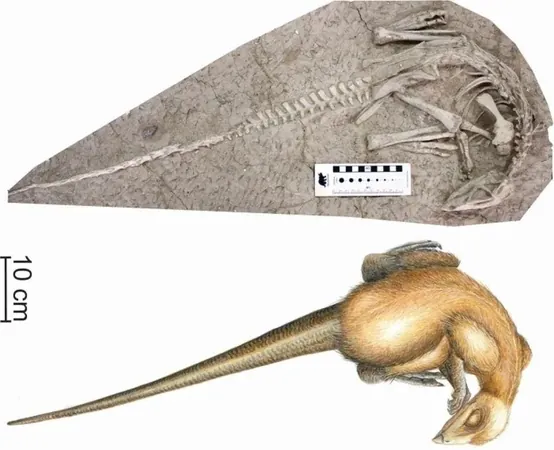
Groundbreaking Discovery Reveals the Secrets Behind the World’s Best-Preserved Dinosaurs
2024-11-10
Author: Emma
Introduction
In an astonishing revelation, researchers have finally pieced together the mystery of the remarkable preservation of fossils originating from the Yixian Formation in Liaoning Province, northeast China—a geological treasure trove dating back 120 to 130 million years. This site has provided paleontologists with an impressive array of well-preserved fossils, including insects, plants, fish, and hundreds of skeletons of feathered dinosaurs that have captivated the scientific community for over two decades.
Revising the Prevailing Theory
For years, the prevailing theory suggested that these fossils were preserved due to sudden burial during volcanic eruptions, akin to the catastrophic events that enveloped Pompeii over two millennia ago. The formations were even dubbed the “Chinese Pompeii.” However, recent groundbreaking research has thrown this theory into question. A new study conducted by a team led by Scott MacLennan from the University of the Witwatersrand reveals that the preservation of these remarkable fossils actually occurred over a significantly shorter timeframe—less than 93,000 years—during which volcanism was absent.
The Role of Ordinary Events
The revised understanding posits that instead of explosive volcanic activity, mundane events such as the collapse of animal burrows during heavy rainfall were responsible for the extraordinary state of the fossils. Paul Olsen, a paleontologist from the Columbia Climate School, stated, “These are probably the most important dinosaur discoveries of the last 120 years.” He emphasized the danger of attributing extraordinary causes to ordinary events when the origins are unclear.
Challenging Previous Hypotheses
Previous hypotheses suggested that lahars—mudflow mixtures that pour down volcanoes—enveloped the remains. Yet, Olsen argues that lahars are inherently violent and would likely obliterate anything in their path, including fleshy remains. Similarly, while pyroclastic flows devastated Pompeii, the remains preserved there bear little resemblance to those found in the Yixian Formation. For example, victims of pyroclastic flows often exhibit contorted positions due to the heat of the eruption, whereas the dinosaurs and other animals in the Yixian site were often discovered in relaxed postures, as if they were peacefully asleep. A notable specimen, now named Changmiania liaoningensis, translates to "Eternal Sleeper from Liaoning."
Evidence Supporting New Theory
The evidence points toward sudden burrow collapses that coincided with a wetter climate of the period, potentially triggered by heavy rainfall destabilizing the soil. The examination of rock cores surrounding the fossils indicates that the fine grains surrounding the skeletal remains suggest there was ample oxygen following the collapse—allowing bacterial action to degrade soft tissue while preserving more resistant bones.
Unique Fossil Finds
This new perspective also accounts for unique fossil finds, such as an early mammal embroiled in a struggle with a small dinosaur during a catastrophic burrow collapse.
Advanced Techniques Used
The study employed advanced techniques using zircon mineral grains to determine the age of the fossils and the surrounding geological materials accurately. By measuring the ratios of radioactive uranium to lead in these minerals, the researchers could ascertain that the fossils dated to around 125.8 million years ago.
Broader Implications
Olsen's research indicates that the success of the Yixian Formation is not an isolated phenomenon. With similar environments identified in places like the eastern United States—including a noteworthy quarry across the North Carolina-Virginia border—there's much more to discover. These sites could potentially yield fossils with preservation on par with those found in Liaoning, bridging the past and present in the quest to understand these ancient beings.
Conclusion
The full study, titled "Extremely rapid, yet noncatastrophic, preservation of the flattened-feathered and 3D dinosaurs of the Early Cretaceous of China," has been published in the *Proceedings of the National Academy of Sciences* and is poised to revolutionize our understanding of fossilization processes. Stay tuned—this is just the beginning of a deeper dive into the prehistoric wonders that still hold mysteries waiting to be unearthed!









 Brasil (PT)
Brasil (PT)
 Canada (EN)
Canada (EN)
 Chile (ES)
Chile (ES)
 España (ES)
España (ES)
 France (FR)
France (FR)
 Hong Kong (EN)
Hong Kong (EN)
 Italia (IT)
Italia (IT)
 日本 (JA)
日本 (JA)
 Magyarország (HU)
Magyarország (HU)
 Norge (NO)
Norge (NO)
 Polska (PL)
Polska (PL)
 Schweiz (DE)
Schweiz (DE)
 Singapore (EN)
Singapore (EN)
 Sverige (SV)
Sverige (SV)
 Suomi (FI)
Suomi (FI)
 Türkiye (TR)
Türkiye (TR)